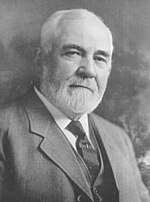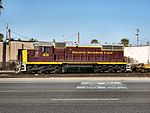Wilmington Oil Field

The Wilmington Oil Field is a prolific petroleum field in Los Angeles County in southern California in the United States. Discovered in 1932, it is the third largest oil field in the United States in terms of cumulative oil production. The field runs roughly southeast to northwest through the Los Angeles Basin, stretching from the middle of San Pedro Bay through Long Beach and east of the Palos Verdes Peninsula. The field originally contained approximately 3 billion barrels (480,000,000 m3) of reserves. In 2013, the USGS estimated future potential production from the combined Wilmington-Belmont oilfield could be around 900 million barrels (140,000,000 m3). The offshore portion of the oil field is developed largely through wells drilled directionally from THUMS Islands, four artificial islands in Long Beach Harbor.
Excerpt from the Wikipedia article Wilmington Oil Field (License: CC BY-SA 3.0, Authors, Images).Wilmington Oil Field
Edison Avenue, Long Beach
Geographical coordinates (GPS) Address Nearby Places Show on map
Geographical coordinates (GPS)
| Latitude | Longitude |
|---|---|
| N 33.771 ° | E -118.2247 ° |
Address
Edison Avenue
90813 Long Beach
California, United States
Open on Google Maps








